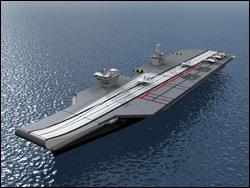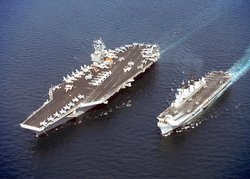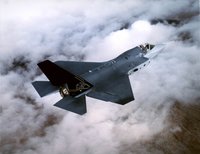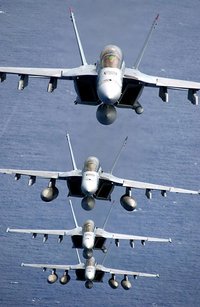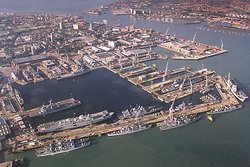Royal Navy CVF programme
|
|
CVF, literally Aircraft Carrier Future, but commonly called the Future Carrier is a new generation of aircraft carrier being developed for the United Kingdom's Royal Navy. The two vessels are expected to enter service in 2012 and 2015.
| Contents |
Background
| Missing image Hmsinvincible.750pix.jpg HMS Invincible, to be replaced by the CVF carriers |
The vessels will displace approximately 60,000 tonnes—almost three times the displacement of the current British Invincible class of aircraft carriers and field an air wing of around 42 F-35 Joint Strike Fighters. In context this is almost three times the size of the Tornado GR1 force deployed in Operation Desert Fox and exactly the same number as the Tornado GR4/Harrier GR7 offensive fleet which participated in Operation Telic. Both of these land based deloyments required the agreement of a local friendly nation.
Total cost of the development and production is put at £3Bn ($5.5Bn), in context two Nimitz class carriers cost approximately £4.4Bn ($8Bn) to build. The carriers will be based in Portsmouth, Hampshire.
While it has been suggested that reducing the carrier force by one vessel will lead to a reduction in the ability of the Royal Navy to project carrier air power, it is planned that advanced design and maintenance techniques will eliminate the present requirement for major refits. At present one carrier is in active duty (R2 - 2 days readiness,) one in reserve or refit (R6 - 60 days notice) and a third in training or maintainence.
The vessels will be the largest and most powerful surface warships ever built in the UK and the most capable aircraft carriers outside of the U.S. Navy. It has been reported that the French Marine Nationale intends to build a second aircraft carrier to a similar design, see Future French aircraft carrier. The French Navy is understood to be unwilling to proceed with another nuclear powered carrier of the Charles de Gaulle design due to the problems and costs experienced both building and operating that ship.
Requirement
The United Kingdom's present aircraft carriers are the three 22,000 tonne Invincible class vessels; Invincible, Illustrious and Ark Royal. The vessels entered service in 1980, 1981 and 1985 respectively. The Invincible class was designed for Cold War anti-submarine warfare in the North Atlantic and has limited space for offensive aircraft (nine Harrier GR7s or Sea Harriers)
In 1982 Invincible joined the taskforce dispatched to recover the Falkland Islands, this conflict demonstrated the need to maintain aircraft carriers to support the United Kingdom's foreign policy. Since the end of the Cold War the Invincible class has operated in a more traditional aircraft carrier mission: power projection. As a result Royal Air Force Harrier GR7 have routinely deployed on the class and the ships have been modified to carry more aircraft and ammunition (notably with the removal of the Sea Dart weapon system).
However the capability of the Invincible class has been limited by the size of the vessels. Studies began as early as 1994 regarding the replacement of the ships since when it has become clear that larger carriers with a larger airgroup are necessary.
Strategic Defence Review
In May 1997 the election of the new Labour government saw the launch of the Strategic Defence Review (SDR). This review re-evaluated every weapon system (active or in procurement) with the exception of the Eurofighter Typhoon and the Vanguard class Trident submarines. The report in December 1998 concluded that aircraft carriers offered the following:
- Ability to operate offensive aircraft abroad when foreign basing may be denied.
- All required space and infrastructure; where foreign bases are available they are not always available early in a conflict and infrastructure is often lacking.
- A coercive and deterrent effect when deployed to a trouble spot.
The report concluded:
- "The emphasis is now on increased offensive air power, and an ability to operate the largest possible range of aircraft in the widest possible range of roles. When the current carrier force reaches the end of its planned life, we plan to replace it with two larger vessels. Work will now begin to refine our requirements but present thinking suggests that they might be of the order of 30,000-40,000 tonnes and capable of deploying up to 50 aircraft, including helicopters."
The need for the carriers was again confirmed in the 2002 SDR New Chapter and the 2004 Delivering Security in a Changing World review which cut many other requirements.
Design studies
In January 1999 six companies were invited to tender for the assesment phase of the project; Boeing, British Aerospace, Lockheed Martin, Marconi Electronic Systems, Raytheon and Thomson-CSF. With the type of aircraft yet to be selected the possible configurations of the vessels was varied:
- STOVL - Joint Strike Fighter
Short Take-Off/Vertical Landing (STOVL), the current choice for UK carrier air power. A STOVL CVF would remove the need for costly steam catapaults and arrestor gear (i.e. CTOL), and would also take advantage of the UK lead in STOVL technology. This is at the expense of aircraft range and payload capability (for an equal size CTOL carrier). Importantly however the difference in capability between a CTOL JSF and STOVL JSF is slight compared to the gulf in capability between the Harrier and, for example, the F/A-18. - STOBAR - Eurofighter Typhoon (Naval)
Short Take-Off But Arrested Recovery (STOBAR) again removes the requirement for the expense of catapaults but uses arrestor gear. In this way conventional aircraft (with modification) can be used. Any STOBAR design would most likely have used a navalised version of the Eurofighter Typhoon; i.e. strengthened landing gear, improved FCS and inclusion of an arrestor hook. The advantages of this would be increased range, manouverability and payload compared to a STOVL design and higher operating efficiency than a CTOL design. Disadvantages include lower stealth characteristics than the JSF and the very high cost of navalising the Typhoon (with little or no export potential). - CTOL - F/A-18E/F Super Hornet - Rafale-M
A Conventional Take-Off and Landing CVF would have used catapaults and arrestor cables and an angled flight deck with existing naval aircraft, most likely the F/A-18 or Rafale-M. This has the advantage of reducing technical risk for development of both the aircraft and carriers and offering maximum payload and range capabilities. Disadvantages outweigh these however, including higher operating costs and the minimal British involvement in development of the aircraft due to the "off-the-shelf" purchase. - "Hybrid"
A late BAE submission was a hybrid carrier, featuring a STOVL ski-jump with angled flight deck, catapaults and arrestor cables. Advantages of this design include the ability to operate STOVL offensive aircraft and CTOL AEW aircraft.
In November 1999 the MoD awarded detailed assessment studies to two consortia, one led by BAe (renamed BAE Systems on November 30) and one lead by Thomson-CSF (renamed Thales Group in 2000). The brief required up to six designs from each consortium with airgroups of 30 to 40 Future Joint Combat Aircraft (FJCA).
Aircraft and carrier format selection
On January 17 2001 the UK signed a Memorandum of Understanding (MoU) with the US Department of Defense for full participation in the Joint Strike Fighter project, confirming the JSF as the FJCA. This gave the UK siginificant input into aircraft design and the choice between the Lockheed X-35 and Boeing X-32. On October 26 2001 the DoD announced that Lockheed Martin had won the JSF contract.
On September 30 2002 the MoD announced that the Royal Navy and RAF will operate the STOVL F-35B variant. At the same time it was announced that the carriers would take the form of large, conventional carriers, which will be adapted for STOVL operations. The carriers, expected to remain in service for 50 years, will be convertible to CTOL operations for the generation of aircraft after the F-35.
Carrier Alliance
On January 30 2003 the Defence Secretary Geoff Hoon announced that the Thales Group design had won the competition but that BAE Systems would operate as prime contractor. These two companies, with the MoD, formed the "Carrier Alliance."
During a speech on July 21 2004 Geoff Hoon announced a one year delay to allow contractural and cost issues to be resolved. In February 2005 the MoD announced that Kellog Brown & Root UK Ltd had been selected as "Physical Integrator" for the project, overseeing the finalisation of the design and the construction process. This was due to concerns that neither BAE nor Thales had the capacity to oversee the construction on their own.
Design
Cvf-bae-blocks.jpg
The first steel is due to be cut in 2006 and the two carriers should enter service in 2012 and 2015.
The design features two small island structures, as opposed to the large single island of the Nimitz class, and two deck lifts. These will operate in the Short Take-Off/Vertical Landing (STOVL) role. The carrier will initially be fitted with a ski-jump which but will be fully convertible to the Conventional Take-Off and Landing (CTOL) role. This will allow a second generation of aircraft to operate from the vessels after the expected 20 year service life of the F-35.
Assembly is expected to be carried out at Rosyth in Scotland, United Kingdom on the Firth of Forth, a naval base one mile (1.6 km) south of Dunfermline.
Carrier Air Group
The vessels are expected to be capable of carrying 48 F-35s, four airborne-early-warning (AEW) aircraft and six support/anti-submarine helicopters, for example the AgustaWestland EH101. The crew will be about 600, only 15 more than the Invincible, indicating the high level of automation being integrated into the ships' systems.
Powerplant
The MOD has decided not to use nuclear propulsion for the aircraft carrier because of high costs. The carrier's propulsion system will be Integrated Full Electric Propulsion (IFEP) based on four gas turbines. It is expected that the Royal Navy will continue its investment in the WR-21 advanced cycle gas turbine engines for the carrier. The optimum location for the position of the main propulsion system is being examined, with maximising the hangar space below decks a major consideration. The unrefuelled range of the carrier will be 10,000nm.
Future proof
The UK has opted to build a larger carrier than strictly necessary for operation of the STOVL F-35 version. This allows the carrier to be designed for, but not with, catapults and arrestor wires for conventional aircraft launch and recovery (CTOL.) The carrier is thus said to be future proof, allowing it to operate a generation of aircraft beyond the F-35.
Size issues
It has been alleged that the large size of the carrier is a major problem.
With the proposed specification of 65,000 tonnes displacement and a length of 274m (900ft) there is no suitable dry dock for a CVF at either of the RN's main two naval bases, their home base of Portsmouth Naval Base or Devonport Naval Base. The No.10 Dock at Devonport is restricted to ships of about 40,000 tonnes and 259m (850ft) length, while the biggest two docks at Portsmouth are slightly smaller (259 m long with a 33m beam, 256 m long respectively). Lengthening of any of these docks, or the construction of a new dry dock, would be a major and expensive exercise.
Plans are advanced for the dredging of the approaches to the harbour, the harbour's main channel and the refurbishment of several jetties prior to the arrival of the first vessel in 2010.
Naming
In 1998 George Robertson joked that the best way to guarantee funding for the programme was to name the lead ship HMS Gordon Brown, after the Chancellor of the Exchequer. Although not confirmed, the following names have been leaked and reported in the UK media;

